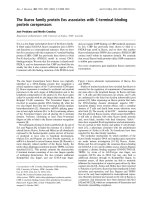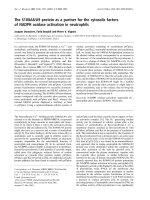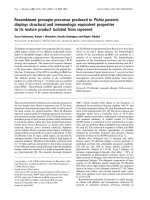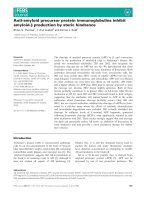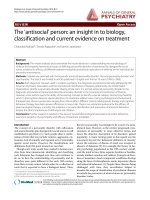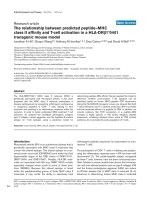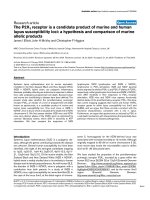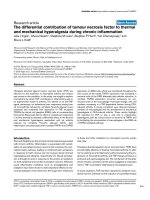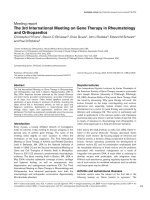Báo cáo Y học: The amyloid precursor protein interacts with neutral lipids Liposomes and monolayer studies pdf
Bạn đang xem bản rút gọn của tài liệu. Xem và tải ngay bản đầy đủ của tài liệu tại đây (631.98 KB, 9 trang )
The amyloid precursor protein interacts with neutral lipids
Liposomes and monolayer studies
Raghda Lahdo
1
, Ste
´
phane Coillet-Matillon
1
, Jean-Paul Chauvet
2
and Laurence de La Fournie
`
re-Bessueille
1
1
Laboratoire de Physico-Chimie Biologique, Universite
´
Claude Bernard, Lyon, France;
2
IFOS, Equipe Bioinge
´
nierie et Reconnaissance
Ge
´
ne
´
tique, Ecully, France
The amyloid protein precursor (APP) was incorporated into
liposomes or phospholipid monolayers. APP insertion into
liposomes required neutral lipids, such as
L
-a-phospha-
tidylcholine, in the target membrane. It was prevented in
vesicles containing
L
-a-phosphatidylserine. The insertion
was enhanced in acidic solutions, suggesting that it is
modulated by specific charge/charge interactions. Surface-
active properties and behaviour of APP were characterized
during insertion of the protein in monomolecular films of
L
-a-phosphatidylcholine,
L
-a-phosphatidylethanolamine or
L
-a-phosphatidylserine. The presence of the lipid film
enhanced the rate of adsorption of the protein at the inter-
face, and the increase in surface pressure was consistent with
APP penetrating the lipid film. The adsorption of APP on
the lipid monolayers displayed a significant head group
dependency, suggesting that the changes in surface pressure
produced by the protein were probably affected by electro-
static interactions with the lipid layers. Our results indicate
that the penetration of the protein into the lipid monolayer is
also influenced by the hydrophobic interactions between
APP and the lipid. CD spectra showed that a large pro-
portion of the a-helical secondary structure of APP
remained preserved over the pH or ionic strength ranges
used. Our findings suggest that APP/membrane interactions
are mediated by the lipid composition and depend on both
electrostatic and hydrophobic effects, and that the variations
observed are not due to major secondary structural changes
in APP. These observations may be related to the parti-
tioning of APP into membrane microdomains.
Keywords: amyloid precursor protein; liposomes; monolayer;
phospholipids; protein–lipid interactions.
Limited proteolysis of the amyloid precursor protein (APP)
generates the amyloid-b-protein (Ab), which is a major
component of brain senile plaques in Alzheimer’s disease
(AD) [1,2]. APP occurs in neural and non-neural tissues as
several membrane-associated glycoproteins of 110–135 kDa
[3]. It is a N- and O-glycosylated single-chain molecule
consisting of 770 amino acid residues, with an isoelectric
point of 4–5. The APP gene is expressed in brain and in
several peripheral tissues, but the physiological functions of
APP and its role in the disease are still poorly understood. A
recent report proposed that APP normally behaves in the
brain as a cell surface signalling molecule, and that an
alteration of this function is one of the possible causes of the
neurodegeneration and consequent dementia in AD [4]. The
Ab peptide is produced in the endosomal compartment and
in the endoplasmic reticulum or Golgi complex [5,6]
through the sequential action of b-andc-secretases [7–12].
APPcouldalsobecleavedbyana-secretase, within the Ab
sequence, thus preventing amyloidogenesis, and results in
the secretion of the larger soluble amino-terminal product
(sAPP; reviewed [13]). The molecular mechanism involved
in APP cleavage and Ab production has still to be resolved.
Minor changes of the membrane lipid composition could
affect the stability of APP as well as its processing, or alter
the function of secretases within the membrane and their
activities towards APP. For example, modifications of the
cholesterol content result in the alteration of Ab secretion
[14], or in the variation of sAPP release from neuronal cells
[15]. Recent papers suggest that cholesterol levels regulate
Ab production and Alzheimer’s disease pathology by acting
on the multiple enzymes which regulate the APP processing
[16–18]. X-ray diffraction studies show that membranes
isolated from AD brains are thinner than those obtained
from age-matched control brains [19]. This alteration in
membrane thickness may change the spatial relationship
between membrane-associated proteases and APP, modify-
ing the amyloidogenic cleavage of the protein.
In vivo, monomeric Ab appears to be a normal constitu-
ent of cerebrospinal fluid but during normal aging or as a
result of a disease process, Ab self associates into fibres that
precipitate as plaques in the brain. In vitro, the toxicity of Ab
is clearly correlated with the aggregation into cross-
b-pleated sheet fibrils. This process is enhanced by increasing
the concentration of Ab or by altering the pH or the ionic
strength [20,21]. The fibrillogenic properties of the Ab
peptide are highly dependent on the membrane composition
[22–25]. A growing number of studies indicate that Ab may
alter the physicochemical properties of neuronal mem-
branes, including membrane fluidity, membrane permeab-
ility to ions and lipid peroxidation [26–29]. These studies
Correspondence to L. de La Fournie
`
re – Bessueille, Laboratoire de
Physico-Chimie Biologique, UMR CNRS 5013, Baˆ timent
E. Chevreul, Universite
´
Claude Bernard, Lyon I, 43 bd du 11
novembre 1918, 69622 Villeurbanne cedex, France.
Fax:+33472431543,Tel.:+33472448324,
E-mail:
Abbreviations: AD, Alzheimer’s disease; Ab, amyloid peptide; APP,
amyloid precursor protein; b-OG, n-octyl b-
D
-glucopyranoside; LUV,
large unilamellar vesicles; PtdCho, phosphatidylcholine; PtdEtn,
phosphatidylethanolamine; PtdSer, phosphatidylserine.
(Received 10 January 2002, revised 11 March 2002,
accepted 15 March 2002)
Eur. J. Biochem. 269, 2238–2246 (2002) Ó FEBS 2002 doi:10.1046/j.1432-1033.2002.02882.x
show that at least some of the physiological effects of Ab
may involve direct interactions between the peptide and the
membrane lipids. However, the mechanisms of Ab–mem-
brane interaction are still unclear. As no data exist on the
binding of APP itself to the lipid membrane, it is of great
interest to examine the interactions of APP with lipids. In
the present study, we have investigated the ability of APP to
interact with lipids. The potential interactions of the protein
with lipid membranes were characterized using two approa-
ches. In the first, the insertion of APP into liposomes was
analysed via a detergent-mediated reconstitution procedure.
In the second, the interaction of the protein with a
monomolecular lipid film was characterized using the
Langmuir technique. The role of electrostatic and hydro-
phobic effects in APP association with lipids was investi-
gated in more detail under various conditions involving
different ionic strengths and pH, with respect to the
structure of the protein.
MATERIALS AND METHODS
APP was purified from porcine brains as described previ-
ously [30]. The procedure yields homogeneous preparations
as judged by SDS/PAGE. The protein concentration was
determined by the Bradford assay [31] using BSA as a
standard.
L
-a-phosphatidylcholine from egg yolk (PtdCho),
L
-a-phosphatidylethanolamine from egg yolk (PtdEtn),
L
-a-phosphatidylserine from bovine brain (PtdSer) and
n-octyl-b-
D
-glucopyranoside (b-OG) were from Sigma.
125
I-labeled APP was prepared by the chloramine T method
to obtain a final specific radioactivity of 79 MBqÆnmol
)1
.
All other reagents were of analytical grade.
Preparation of liposomes
Vesicles were obtained by dialysis as described by Angrand
et al. [32] or by extrusion as follows: large unilamellar
vesicles (LUV) were prepared from a phospholipid stock
solution dissolved in chloroform/methanol (2 : 1). The
resulting solution was then evaporated to dryness under a
stream of nitrogen and the last traces of solvent subse-
quently removed by a further 3–6 h evaporation period
under vacuum. The remaining lipid film was then hydrated
in 20 m
M
Tris/HCl, 150 m
M
NaCl pH 7.4 at a higher
temperature (room temperature) than the phase transition
temperature of the corresponding lipid and dispersed
vigorously by vortexing. LUV were formed using six fast
freeze–thaw cycles. They were subsequently extruded 19
times through two polycarbonate membranes (400 and
200 nm pore size), using a mini extruder (Avanti Polar). The
final phospholipid concentration was 20 mgÆmL
)1
.
Preparation of phospholipid–protein complexes
The incorporation of APP into liposomes was performed
using the detergent-mediated procedure described by Le
´
vy
et al. [33]. Briefly, the complexes of phospholipid and
protein were prepared at a phospholipid/protein ratio of
500 : 1 (w/w). The lipid/protein mixture containing trace
amounts of
125
I-labeled APP was incubated with the desired
concentration of b-OG. The excess of detergent was then
removed by extensive dialysis against 20 m
M
Tris/HCl,
150 m
M
NaCl, pH 7.4 buffer. The resulting solution was
mixed with an equal volume of 60% (w/v) sucrose in 20 m
M
Tris/HCl, 150 m
M
NaCl, pH 7.4 buffer. A 5–25% sucrose
gradient was poured on the top of the 30% layer and
samples were centrifuged at 160 000 g for 3 h at 4 °C.
Fractions (0.5 mL) from the gradient were subsequently
collected from the bottom of the tube and the lipid and
protein contents were analysed. The lipid content was
determined by comparison with a specific experiment using
3
H[PtdCho] detection. Lipids were found to be present
mainly at a sucrose concentration of % 15%. The presence
of APP was determined by measurement of
125
I-labeled
APP radioactivity. Percentage incorporation was defined as
the ratio between the radioactivity recovered in liposomal
fractions and the total radioactivity loaded on the gradient.
It corresponds to the percentage of APP inserted into
liposomes. The reconstitution was performed under differ-
ent conditions, at varying pH and salt concentrations.
Monolayer measurements
Measurements were recorded at 21 °C using a Teflon
trough (Riegler and Kirstein, Germany). Adsorption of the
protein was performed at a constant surface area either in a
small Teflon dish (diameter, 1.6 cm) with a subphase
volume of 4 mL or with a larger Teflon dish (diameter,
3.4 cm) with a subphase volume of 19 mL. The surface
pressure was measured as a function of time by the
Wilhelmy plate method using plates cut from filter paper
(Whatman no. 1) and a computer-controlled transducer
readout. The surface activity of the protein was recorded at
a free water interface and characterized in the presence of a
preformed lipid monolayer. Lipid monolayers were spread
at the air–water interface from a chloroform solution to give
an initial surface pressure (p
i
). Ten minutes after the
formation of the monolayer, a desired volume of APP in
20 m
M
Tris/HCl, 150 m
M
NaCl pH 7.4 or in Tris/maleate
20 m
M
,150 m
M
NaCl pH 7, was injected below the surface.
The subphase was stirred continuously with a Teflon-coated
stirring bar and a magnetic stirrer. In similar experiments,
we examined the effect of pH or NaCl concentrations in the
subphase buffer on the adsorption characteristics of APP in
the absence or in the presence of a phospholipid monolayer.
CD spectroscopy
Far-UV CD spectra of APP were recorded on a Jobin-Yvon
CD6 spectropolarimeter. All measurements were done at
25 °C in a 0.05-mm path length quartz cell with an APP
concentration of 0.15 mgÆmL
)1
in the appropriate buffer
(10 m
M
NaH
2
PO
4
/Na
2
HPO
4
). Blanks (various buffers with
or without lipids) were routinely recorded and substracted
from the original spectra.
RESULTS
Incorporation of APP into liposomes
We studied the ability of the protein to insert into preformed
liposomes, via a detergent-mediated procedure, to investi-
gate the potential association of APP with a lipid mem-
brane. The complexes generated between the protein and
lipids in the presence of b-OG were fractionated on a
discontinuous sucrose density gradient and the amount of
Ó FEBS 2002 Interaction of amyloid precursor protein with lipids (Eur. J. Biochem. 269) 2239
radiolabelled APP associated with liposomes was deter-
mined. Control experiments showed that all the radioactiv-
ity associated with pure APP in the absence of liposomes
was recovered at the bottom of the gradient (25% sucrose),
while pure phospholipid liposomes were collected at a
sucrose concentration of 15%. After a 20-h dialysis period
of the reconstitution mixture composed of APP, PtdCho
liposomes and b-OG, we observed a comigration of
phospholipid and protein over a relatively narrow density
range, at % 15% sucrose. A small fraction of the protein was
associated with the lipid, and % 80%freeproteinwas
recovered at the bottom of the gradient (Fig. 1). The
presence of the free protein indicates a low incorporation
efficiency of APP during the reconstitution procedure. The
influence of lipid/protein ratio on efficiency of protein
incorporation into liposomes during reconstitution was
examined. Proteoliposomes samples containing APP and
PtdCho liposomes were incubated in the presence of b-OG
at initial phospholipid/protein ratios of 1000 : 1, 500 : 1 or
200 : 1 (w/w). Most of the protein migrated at the bottom
of the gradient (Fig. 1), which indicated incomplete incor-
poration of APP into liposomes whatever the lipid/protein
ratio. Therefore, the following experiments were carried out
with phospholipid/protein ratio of 500 : 1. Reconstitution
experiments performed with ionic or zwitterionic detergents
were less efficient and less reproducible. The role of different
phospholipids in the insertion of APP into lipid bilayers was
examined (Fig. 2). Vesicles containing PtdEtn/PtdCho
(molar ratio 62.5 : 37.5) did not change the incorporation
rate of APP into the membrane. However, PtdSer-contain-
ing liposomes totally prevented the binding of APP to the
phospholipid membrane. These results suggest that charge–
charge interactions between phospholipids and APP are
involved in the protein insertion process to the membrane.
We repeated these experiments at various pH or with higher
concentrations of NaCl in the buffer. The APP incorpor-
ation was increased threefold to fourfold at acidic pH for
neutral phospholipids (PtdCho or PtdCho/PtdEtn vesicles)
as shown in Fig. 2. These results indicate that APP insertion
in the lipid bilayer is enhanced at a pH close to the pI of the
protein. An increasing salt concentration lead to a decreased
incorporation rate of APP into preformed LUVs to
approximatively zero at 0.3
M
NaCl (data not shown).
These data show that APP insertion in the lipid bilayer is
inhibited by a high concentration of salt.
Monolayer experiments
Adsorption of APP at the air–water interface. The surface
pressure (p) was measured as a function of time for various
subphase concentrations of APP in the absence of pre-
formed lipid films (subphase: 20 m
M
Tris/HCl, 150 m
M
NaCl, pH 7.4) (Fig. 3). When the subphase concentration
of APP was < 0.2 lgÆmL
)1
, no significant changes in the
surface pressure were detected during 120 min (not shown).
The effects of higher concentrations of APP on the surface
pressure are shown in Fig. 3A. The results showed that the
final surface pressure increased with APP concentration in
the subphase, an indication that the interface was not
saturated by the protein, for concentrations up to
1 lgÆmL
)1
. Moreover, the surface pressure increase does
not occur immediately after the injection of the protein into
the subphase (Fig. 3A). For protein concentrations of 0.35,
0.5, 1 and 2 lgÆmL
)1
the surface pressure started to increase
after 90, 50, 20 and 10 min, respectively. For the lowest APP
concentration used, the observed lag time reached several
hours. The sigmoidal shape of the p vs. time curve suggests
the occurrence of a co-operative process. These results
indicate that the adsorption of APP at the air–water
interface is both concentration- and time-dependent. The
process of the protein adsorption can be analysed by a first
order equation:
Fig. 1. Density gradient centrifugation profiles for APP liposomes
reconstituted from b-OG. Liposomes (1 mg) were incubated with b-OG
(16 m
M
) and APP. The detergent was removed by dialysis, the samples
were then submitted to a flotation on discontinuous sucrose gradients.
Fractions (0.5 mL) were collected from the bottom of the gradient and
APP content was measured by assaying for
125
I-labeled APP. (- - -,
1 lg APP; –––, 2 lg APP; – ) –, 5 lg APP).
Fig. 2. Effect of lipid composition and pH on the incorporation of APP
into phospholipid vesicles. Percentage of incorporation of APP into
liposomes composed of 1 mg phospholipids (d, PtdCho; r,PtdCho/
PtdEtn; j, PtdSer) mixed with b-OG (16 m
M
,20m
M
and 14 m
M
,
respectively) and APP (2 lg) at different pH. After dialysis against the
same buffer as that used for incubation, proteoliposomes were separ-
ated on a discontinuous sucrose gradient. The
125
I-labeled APP was
measured in the collected fractions (0.5 mL). The percentage of
incorporation was calculated as follows: [
125
I-labeled APP radio-
activity associated with liposomes/total
125
I-labeled APP radioactivity
loaded on the gradient] · 100.
2240 R. Lahdo et al. (Eur. J. Biochem. 269) Ó FEBS 2002
ln
p
e
À p
p
e
À p
0
¼À
t
s
ðEqn 1Þ
where p
e
, p, p
0
, are the surface pressure values at steady-
state conditions, at time t and at time t ¼ 0, respectively,
and s is the relaxation time.
In order to evaluate the parameters that control the
successive steps of the adsorption of APP at the air/water
interface, the plots of ln(1–p/p
e
) vs. time were obtained
according to Eqn 1. The curves (insert in Fig. 3A) present at
least two linear parts. According to Graham & Phillips’
work [34], the relaxation time s
1
, corresponding to the first
linear part, is corelated with the protein adsorption and
perhaps unfolding at the surface layer, while s
2
, defined by
the second linear part, can be related to a subsequent
interfacial rearrangement of the adsorbed protein molecules.
When APP concentrations were 0.35 and 1 lgÆmL
)1
, s
1
reached 200 and 23 min, while s
2
was around 25 and 75 min,
respectively. From these results, s
1
and s
2
appear to be very
sensitive to the bulk concentration of APP. In the absence of
a lipid monolayer, APP adsorbed at the air–water interface,
leading to a stable monolayer. The surface activity of APP
resulted in a protein monolayer with a surface pressure of
% 12 mNÆm
)1
at pH 7 on a buffer subphase containing at
least 150 m
M
of NaCl (Fig. 3B). The presence of 300 m
M
NaCl in the subphase buffer increased the surface activity of
APP to % 14 mNÆm
)1
and significantly decreased the lag
time (Fig. 3B). This result may indicate an increase of the
hydrophobicity of the protein due to charge neutralization.
The presence of 5 m
M
NaCl in the subphase buffer
decreased the surface activity to 4.5 mNÆm
)1
with a 2-h lag
time (Fig. 3B). The surface activity of the protein in the
absence of lipids was also studied on subphase buffers of
different pH (Fig. 3C). Lowering the pH to 6 did not
promote changes on the final surface pressure of the protein
monolayer, but increased the lag time threefold. At a pH
below 6, longer lag times and lower surface activities for
APP were observed (p
e
¼ 10 mNÆm
)1
at pH 5, and
p
e
¼ 2mNÆm
)1
at pH 4) (Fig. 3C). This result may be
explained by the progressive reduction of the global charge
of the protein as the pH approaches the isoelectric point,
giving a less hydrophilic character to the APP molecule.
Interactions of APP with phospholipid monolayers.
Increase in surface pressure (Dp) vs. time curves (Fig. 4A)
observed for APP adsorption into films of PtdCho (initial
p
i
¼ 10 mNÆm
)1
), at different subphase concentrations,
demonstrated that the rate of adsorption of the protein at
the lipid–water interface increased considerably as com-
pared with the surface activity of the protein at the air–water
interface (i.e., the time to obtain the maximum Dp was
decreased, even at low protein concentrations). The specific
protein concentration used induced no change in surface
tension of the buffer–air interface during 1 h, after which
the protein was injected into the subphase in the absence of
preformed phospholipid monolayer (Fig. 3A). However,
the increase of surface pressure of a preformed phospholipid
monolayer occurred immediately after injection of the
protein under the lipid layer. These results suggested a very
fast diffusion and incorporation process of APP into the
lipid film. The presence of the PtdCho monolayer slightly
increased the final value of the surface pressure increase
produced by the protein at this relatively low initial surface
pressure (Fig. 4A). The effect of the ionic strength was
studied in order to understand the role of electrostatic
shielding in the binding of APP to the phospholipid
membrane. Qualitatively, high ionic strength was found to
increase the binding of APP to the lipid membrane
(Fig. 4B). The effect of pH on the APP surface activity
was also analysed. In contrast to the pH dependence
observed with APP during the detergent-mediated recon-
stitution, no changes in the surface pressure due to the
incorporation of the protein was observed in a pH range of
4–8 (Fig. 4C). Finally, the interactions of APP with spread
monolayers of various phospholipids were studied at a low
concentration of APP. Fig. 5A shows typical records of the
Fig. 3. Kinetics recording the surface behaviour of APP at the air–water
interface. (A) p–t curves corresponding to the penetration of APP into
the air–water interface under different bulk concentrations of the
protein (buffer: Tris/HCl 20 m
M
, NaCl 150 m
M
,pH7;Teflontrough
19 mL, 9 cm
2
). Insert: Ln (1-p/pe)) vs. t plots for the adsorption of
APP into the air–water interface. Protein concentrations in the bulk
are 0.35 lgÆmL
)1
(a) and 1 lgÆmL
)1
(b). (B) p–t curves corresponding
to the penetration of APP into the air–water interface in the presence
of various salt concentrations (buffer: Tris/maleate 20 m
M
,pH7;
Teflon trough 4 mL, 2 cm
2
). (C) p–t curves corresponding to the
penetration of APP into the air–water interface under various pH
(buffer: Tris/maleate 20 m
M
,NaCl150m
M
;Teflontrough4mL,
2cm
2
).
Ó FEBS 2002 Interaction of amyloid precursor protein with lipids (Eur. J. Biochem. 269) 2241
surface pressure as a function of time corresponding to the
insertion of APP into PtdCho, PtdEtn or PtdSer mono-
layers spread at an initial surface pressure of p
i
¼
10 mNÆm
)1
±1mNÆm
)1
. PtdCho, PtdEtn and PtdSer
showed essentially identical surface pressure-area isotherms
and thus have an identical head group spacing at a given
surface pressure, despite some potential differences in acyl
group conformations [35]. The adsorption of the protein to
the phospholipid monolayer produced a change in the
surface pressure (Dp)of% 5mNÆm
)1
for both PtdCho and
PtdEtn monolayers (Fig. 5A). The same surface pressure
increase was observed when APP was diluted (final
concentration of 0.35 lgÆmL
)1
) in the buffer subphase
before the lipid monolayer was formed (data not shown).
Comparison of the results for p
i
¼ 5mNÆm
)1
with those for
higher p
i
are illustrated in Fig. 5B [Dp ¼ f(p
i
)]. The data
suggest that the increase in the surface pressure Dp due to
the adsorption of APP on the phospholipid monolayers is
dependent on the initial surface pressure of the lipid film.
The similarity of the Dp vs. time profiles for the phosphol-
ipids PtdCho and PtdEtn (Fig. 5A) confirmed the observa-
tion that APP did preferentially interact with either one of
the two phospholipids during adsorption at the air–water
interface. When APP was injected below monolayers of
PtdCho, PtdEtn or PtdSer formed at p
i
above 23, 19 and
11 mNÆm
)1
, respectively, the protein was no longer able to
induce any increase of the surface pressure (Fig. 5B). These
critical surface pressures for APP penetration (p
c
) corres-
pond to the extrapolated initial surface pressures beyond
which no increase in the surface pressure occurred.
CD spectroscopy
NaCl or pH effect on the secondary structure of APP. As
the interaction of APP with lipids is either pH or NaCl
dependent, we have considered the possibility that these
variations may lead to protein conformational changes. The
effect of NaCl on the secondary structure of APP was
studied in the far UV region. Fig. 6A shows the CD spectra
Fig. 5. Surface pressure increase after protein injection under different
phospholipid monolayers. (A) Penetration pressure (Dp) induced by the
insertion of APP into the phospholipid monolayers. (- - -, PtdCho; —–,
PtdEtn; – ) –, PtdSer). Buffer: Tris/HCl 20 m
M
, NaCl 150 m
M
,pH7.
The initial surface pressure was 10 ± 1 mNÆm
)1
(Teflon trough
19 mL, 9 cm
2
). (B) Surface pressure increase after protein injection
with respect to the initial surface pressure of the phospholipid film. (d,
PtdCho; r,PtdEtn:j, PtdSer). Buffer: Tris/HCl 20 m
M
,NaCl
150 m
M
,pH7.(Teflontrough19mL,9cm
2
).
Fig. 4. Kinetics recording the surface behaviour of APP at the phos-
phatidylcholine–water interface. (A) p–t curves of APP inserted into the
PtdCho monolayer under different bulk concentrations of the protein
(buffer:Tris/HCl20m
M
, NaCl 150 m
M
,pH7;Teflontrough19mL,
9cm
2
). (B) p–t curves of APP inserted into the PtdCho monolayer
under different salt concentration (buffer: Tris/maleate 20 m
M
,pH7;
Teflontrough4mL,2cm
2
). (C) p–t curves of APP inserted into the
PtdCho monolayer under different pH (buffer: Tris/maleate 20 m
M
,
NaCl 150 m
M
; Teflon trough 4 mL, 2 cm
2
).
2242 R. Lahdo et al. (Eur. J. Biochem. 269) Ó FEBS 2002
of APP in 10 m
M
NaH
2
PO
4
/Na
2
HPO
4
buffer pH 7 at
varying concentrations of NaCl. The CD spectra were
smoothed, and an analysis of the CD spectrum of APP at
neutral pH and ionic strength (Fig. 6A) yielded 40% a helix
and 20% b sheet structures as reported previously [30]. No
significant variation was observed when the NaCl concen-
tration increased. A slight increase (10%) of the a helix
content was observed for a NaCl concentration of 0.5
M
.
Far-UV CD spectra indicated that APP remains mainly
a-helical at mildly acidic pH, reflecting no major change in
the secondary structure between pH 5 and 7 (Fig. 6B). The
spectrum of APP at pH 4 is somewhat flatter than the
others, reflecting a possible aggregation of the protein as a
consequence of its denaturation in the acidic buffer.
Effect of LUVs. The protein conformation in the presence
of neutral vesicles was analysed by CD spectroscopy (data
not shown). A small decrease of the a helix content of the
protein was observed in the presence of 2 m
M
PtdCho
vesicles. Neutral phospholipid vesicles had a very weak
influence on the protein conformation.
DISCUSSION
In order to get insight into the role of lipids in APP
processing we have characterized its association with
artificial lipid vesicles or lipid monolayers. APP was able
to interact with the membranes of liposomes, although
incomplete APP incorporation into liposomes could be
observed with b-OG-mediated reconstitution. The nonionic
detergent b-OG was used because it is a nondenaturating
detergent with a high critical micellar concentration
(20–25 m
M
). Therefore, it can be rapidly removed by
dialysis [33,36]. The low incorporation rates observed in
b-OG-mediated reconstitution were, however, in the same
range as those observed by Lin et al.[26]forAb incorpor-
ated into liposomes using the sonification technique. The
ability of APP to insert into neutral lipid vesicles was
dependent on pH. Indeed, the binding was greater at low
pH, when the net charge of the protein is close to a nil value,
than at neutral pH, where APP is in an anionic form. It is
more likely that a low pH is required for the protonation of
the negatively charged carboxyl groups of aspartic or
glutamic acids, whose pK values are near 4. The protona-
tion of the carboxyl functions reduce significantly the
repulsion between the negatively charged groups on the
membrane and the negatively charged amino acids present
on APP. This requirement for a low pH suggests that
electrostatic repulsion prevents the protein–membrane
association. Furthermore, no incorporation was obtained
in the presence of negatively charged lipids in the mem-
brane, whatever was the pH. The protonation of the
phospholipid may change at acidic pH: a pKa (COO
–
)of
5.5andapKa(PO
2–
) of 3–4 have been reported for PtdSer
[37]. As APP undergoes a charge change from anionic to
zwitterionic, only a part of PtdSer is protonated and still
presents negative charges. Incorporation at pH lower than 4
was not analysed because these pH values do not corres-
pond to physiological conditions.
APP tends to adsorb on the air–water interface, and the
increase in surface pressure was similar to that observed
with other membrane or soluble proteins [38–40]. As
reported by Graham and Phillips [34], the rate of the
surface pressure change is a function of the stability of the
protein structure, and more flexible molecules give a more
rapid increase of the surface pressure. By analogy with other
proteins [38,39], such a phenomenom suggests that APP
may have a relatively flexible structure. CD experiments
supported this hypothesis as the APP structure contains at
least 30% of random coil in its native form [30]. Determin-
ation of the parameters that control the adsorption of APP
at the air–water interface suggested that the molecular
rearrangement at the interface of the monolayer bearing the
absorbed protein depends on both the activation energy
barrier of the insertion process and the bulk concentration
of the protein. This observation is in agreement with protein
adsorption models [38–40]. Under the experimental condi-
tions used in this study, the interaction of APP with a
neutral lipid monolayer is not dependent on the bulk pH, as
it was observed for binding experiments into liposomes.
These results may be explained by an effect of local
interfacial pH [41]. Therefore, alteration of the charge of the
protein could be induced at the vicinity of the monolayer. A
difference in the orientation of the protein moiety during the
insertion process into the monolayer film or into the bilayer
containing the surfactant is also possible. The lower surface
activity obtained with the PtdSer monolayers could be the
result, as presented before, of an electrostatic repulsion
effect between lipids and the protein at physiological pH.
Anionic lipids, which represent % 20% of biological
membrane lipids, provide either a source of electrostatic
Fig. 6. CD of APP. (A) CD spectra of APP in phosphate buffer 10 m
M
pH 7 as a function of salt concentration (—–, No NaCl; – ) –150m
M
NaCl;- ,500m
M
NaCl). (B) CD spectra of APP in phosphate buffer
10 m
M
NaCl 150 m
M
asafunctionofpH(—–,pH7;––––,pH6,
– ) –, pH 5; - - -, pH 4).
Ó FEBS 2002 Interaction of amyloid precursor protein with lipids (Eur. J. Biochem. 269) 2243
attractions for the binding of proteins to membranes or a
source of repulsive effects [42–44].
The results presented are consistent with the hypothesis
that the binding of APP to phospholipid monolayers is also
driven by hydrophobic interactions, as the increase of salt
concentration favoured the penetration process of the
protein into the monolayer. The binding of APP to
phospholipid films could be linked to a decrease in solubility
of the protein in the bulk phase at high ionic strength,
leading to a greater amount of the protein present at the
interface. In other words, increasing the ionic strength has
the same effect as an increase of the protein hydrophobicity.
As the hydrophobic nature of the interaction is stimulated
by increasing the ionic strength of the subphase, the
insertion rate of APP should be facilitated when the
electrostatic repulsion between the lipid–protein molecules
at the interface occurs. It may be the case for the interaction
of APP with PtdCho monolayers.
We investigated whether the observed changes are due to
conformational changes of APP, associated with secondary,
tertiary or quaternary modifications. Far-UV CD spectra of
APP showed that the protein conformation is slightly
affected by either the pH or the salt concentration, in the
absence or in the presence of PtdCho vesicles. We concluded
that the protein remains essentially in a a-helical structure
under these conditions. We could not exclude, however, that
local changes may occur and escape detection using CD,
given the fact that APP is a large protein. These binding and
CD studies show that the binding is not directly related to
the secondary structure of the protein, as binding can be
modified when secondary structure is not. However, it
should be pointed out that CD spectra of the APP recorded
at pH 4 suggested an aggregation and/or precipitation of
the protein. The possibility that the lower surface activity of
APP observed at pH 4 could be due to a lower available
amount of the protein cannot be ruled out. No loss of
tertiary structure, as measured by intrinsic fluorescence,
indicates that the protein does not undergo major unfolding
during acidification or upon variation of ionic strength
(data not shown). Whether minor conformational modifi-
cations of APP, such as local variations in secondary or
tertiary structures in defined regions of the protein, are
associated with its lipid binding ability remains to be
determined. Finally, we have considered the possibility that
the pH-induced conformational transition may lead to
changes in the protein quaternary structure. We have used
gel filtration chromatography to test this hypothesis, and
have obtained no evidence for a different structure at
pH 4–7 (data not shown). The APP is apparently organized
as a trimer in the conditions used for these studies. It was
recently reported that cellular APP can form noncovalent
homodimers and tetramers [45].
The molecular events which guide protein interaction at
the membrane surface or insertion into lipid vesicles are
important in order to shed light on the toxicity mechanism
of Ab which may be based in part on perturbations of the
lipid–water interface. In vivo,productionofAb is believed to
occur through sequential cleavage of APP by b-and
c-secretases [46]. Cell biological studies suggest three
potential locations for intracellular b-secretase activity:
endosomal compartments at mildly acidic pH, Golgi-
derived vesicles and endoplasmic reticulum/intermediate
compartments. b-secretase has an acidic pH optimum of
% 4.5 [7,9,10]. The final step in the generation of Ab from
the amyloid precursor protein is the proteolysis by the
elusive c-secretase(s) [8,11,12]. From a biological point of
view, the c-secretase cleavage is intriguing and unusual
because it is an intramembranous cleavage. The predicted
transmembrane domain of APP (from Gly625 to Leu648)
ends just before the putative c-secretase cleavage site
(Lys649–Lys651), which implies that the c-secretase clea-
vage sites are located in the hydrophobic environment of the
cell membrane. The in vitro model where APP is incorpor-
ated into lipid layers could support the precision of the
mechanism of proteolysis, and emphasize the lipid param-
eters that influence this process.
At this point, it is interesting to note that numerous
studies have detected extensive interactions between Ab
and anionic lipids. More recently, different studies have
suggested that cholesterol, an important determinant of
the physical state of biological membranes, plays a
significant role in the development of AD. Whether this
particular lipid has an effect on the insertion or on the
interaction of APP with lipid membranes is under
investigation. Although we have shown that the inter-
action of the protein with neutral or anionic model
membranes depends on electrostatic and hydrophobic
effects, the participation of other factors should also be
taken into consideration.
REFERENCES
1. Kang, J., Lemaire, H G., Unterbeck, A., Salbaum, J.M., Masters,
C.L., Grzeschik, K.H., Multhaup, G., Beyreuther, K. & Mu
¨
ller-
Hill, B. (1987) The precursor of Alzheimer’s disease amyloid A4
protein resembles a cell-surface receptor. Nature 325, 733–736.
2. Tanzi, R.E., Gusella, J.F., Watkins, P.C., Bruns, G.A., St George-
Hyslop,P.,VanKeuren,M.L.,Patterson,D.,Pagan,S.,Kurnit,
D.M. & Neve, R.L. (1987) Amyloid b protein gene: cDNA,
mRNA distribution, and genetic linkage near the Alzheimer locus.
Science 235, 880–884.
3. Selkoe, D.J., Podlisny, M.B., Joachim, C.L., Vickers, E.A., Lee, G.,
Fritz, L.C. & Oltersdorf, T. (1988) b-Amyloid precursor protein of
Alzheimer disease occurs as 110- to 135-kilodalton membrane-
associated proteins in neural and nonneural tissues. Proc. Natl
Acad. Sci. USA 85, 7341–7345.
4. Neve, R.L., McPhie, D.L. & Chen, Y. (2000) Alzheimer’s disease:
a dysfunction of the amyloid precursor protein. Brain Res. 886,
54–66.
5. Perez, R.G., Squazzo, S.L. & Koo, E.H. (1996) Enhanced release
of amyloid b-protein from codon 670/671 ÔSwedishÕ mutant
b-amyloid precursor protein occurs in both secretory and endo-
cytic pathways. J. Biol. Chem. 271, 9100–9107.
6. Annaert, W.G., Levesque, L., Craessaerts, K., Dierinck, I.,
Snellings, G., Westaway, D., George-Hyslop, P.S., Cordell, B.,
Fraser,P.&DeStrooper,B.(1999)Presenilin1controlsc-secre-
tase processing of amyloid precursor protein in pre-golgi com-
partments of hippocampal neurons. J. Cell. Biol. 147, 277–294.
7. Hussain, I., Powell, D., Howlett, D.R., Tew, D.G., Meek, T.D.,
Chapman, C., Gloger, I.S., Murphy, K.E., Southan, C.D., Ryan,
D.M., Smith, T.S., Simmons, D.L., Walsh, F.S., Dingwall, C. &
Christie, G. (1999) Identification of a novel aspartic protease
(Asp 2) as b-secretase. Mol. Cell Neurosci. 14, 419–427.
8. Murphy, M.P., Hickman, L.J., Eckman, C.B., Uljon, S.N.,
Wang, R. & Golde, T.E. (1999) c-Secretase, evidence for multiple
proteolytic activities and influence of membrane positioning of
substrateongenerationofamyloidb peptides of varying length.
J. Biol. Chem. 274, 11914–11923.
2244 R. Lahdo et al. (Eur. J. Biochem. 269) Ó FEBS 2002
9. Sinha, S., Anderson, J.P., Barbour, R., Basi, G.S., Caccavello, R.,
Davis,D.,Doan,M.,Dovey,H.F.,Frigon,N.,Hong,J.et al.
(1999) Purification and cloning of amyloid precursor protein
b-secretase from human brain. Nature 402, 537–540.
10. Vassar, R., Bennett, B.D., Babu-Khan, S., Kahn, S., Mendiaz,
E.A., Denis, P., Teplow, D.B., Ross, S., Amarante, P., Loeloff, R.
et al. (1999) b-Secretase cleavage of Alzheimer’s amyloid precursor
protein by the transmembrane aspartic protease BACE. Science
286, 735–741.
11. Esler, W.P., Kimberly, W.T., Ostaszewski, B.L., Diehl, T.S.,
Moore, C.L., Tsai, J.Y., Rahmati, T., Xia, W., Selkoe, D.J. &
Wolfe, M.S. (2000) Transition-state analogue inhibitors
of c-secretase bind directly to presenilin-1. Nature Cell Biol. 2,
428–434.
12. Li,Y.M.,Xu,M.,Lai,M.T.,Huang,Q.,Castro,J.L.,DiMuzio-
Mower, J., Harrison, T., Lellis, C., Nadin, A., Neduvelil, J.G.,
Register, R.B. et al. (2000) Photoactivated c-secretase inhibitors
directed to the active site covalently label presenilin 1. Nature 405,
689–694.
13. De Strooper, B. & Annaert, W. (2000) Proteolytic processing and
cell biological functions of the amyloid precursor protein. J. Cell
Sci. 113, 1857–1870.
14. Simons,M.,Keller,P.,DeStrooper,B.,Beyreuther,K.,Dotti,
C.G. & Simons, K. (1998) Cholesterol depletion inhibits the gen-
eration of b-amyloid in hippocampal neurons. Proc. Natl Acad.
Sci. USA 95, 6460–6464.
15. Galbete, J.L., Martin, T.R., Peressini, E., Modena, P., Bianchi, R.
& Forloni, G. (2000) Cholesterol decreases secretion of the
secreted form of amyloid precursor protein by interfering with
glycosylation in the protein secretory pathway. Biochem. J. 348,
2307–2313.
16. Refolo, L.M., Malester, B., La Francois, J., Bryant-Thomas, T.,
Wang, R., Tint, G.S., Sambamurti, K., Duff, K. & Pappolla, M.A.
(2000) Hypercholesterolemia accelerates the Alzheimer’s amyloid
pathology in a transgenic mouse model. Neurobiol. Dis. 7, 321–
331.
17. Fassbender, K., Simons, M., Bergmann, C., Stroick, M.,
Lutjohann, D., Keller, P., Runz, H., Kuhl, S., Bertsch, T., von
Bergmann, K., Hennerici, M., Beyreuther, K. & Hartmann, T.
(2001) Simvastatin strongly reduces levels of Alzheimer’s disease
b-amyloid peptides Abeta 42 and Abeta 40 in vitro and in vivo.
Proc.NatlAcad.Sci.USA98, 5856–5861.
18. Kojro, E., Gimpl, G., Lammich, S., Marz, W. & Fahrenholz, F.
(2001) Low cholesterol stimulates the nonamyloidogenic pathway
by its effect on the a-secretase ADAM 10. Proc. Natl Acad. Sci.
USA 98, 5815–5820.
19. Mason, R.P., Shoemaker, W.J., Shajenko, L. & Herbette, L.G.
(1993) X-ray diffraction analysis of brain lipid membrane structure
in Alzheimer’s disease and b-amyloid peptide interactions. Ann. N.
Y. Acad. Sci. 695, 54–58.
20. Simmons, L.K., May, P.C., Tomaselli, K.J., Rydel, R.E., Fuson,
K.S., Brigham, E.F., Wright, S., Lieberburg, I., Becker, G.W.,
Brems, D.N. & Li, W.Y. (1994) Secondary structure of amyloid
b-peptide correlates with neurotoxic activity in vitro. Mol. Phar-
macol. 45, 373–379.
21. Buchet, R., Tavitian, E., Ristig, D., Swoboda, R., Stauss, U.,
Gremlich, H.U., de La Fournie
`
re, L., Staufenbiel, M., Frey, P. &
Lowe, D. (1996) Conformations of synthetic b peptides in solid
state and in aqueous solution: relation to toxicity in PC12 cells.
Biochim. Biophys. Acta. 1315, 40–46.
22. Choo-Smith, L P., Garzon-Rodriguez, W., Glabe, C.G. &
Surewicz, W.K. (1997) Acceleration of amyloid fibril formation by
specific binding of Ab-(1–40) peptide to ganglioside-containing
membrane vesicles. J. Biol. Chem. 272, 22987–22990.
23. Terzi, E., Holzemann, G. & Seelig, J. (1997) Interaction of
alzheimer b-amyloid peptide (1–40) with lipid membranes.
Biochemistry 36, 14845–14852.
24. Matsuzaki, K. & Horikiri, C. (1999) Interactions of amyloid
b-peptide (1–40) with ganglioside-containing membranes. Bio-
chemistry 38, 4137–4142.
25. Yip, C.M. & McLaurin, J. (2001) Amyloid-b peptide assembly: a
critical step in fibrillogenesis and membrane disruption. Biophys.
J. 80, 1359–1371.
26. Lin, H., Zhu, Y.J. & Lal, R. (1999) Amyloid b protein (1–40)
forms calcium-permeable, Zn
2+
-sensitive channel in reconstituted
lipid vesicles. Biochemistry 38, 11189–11196.
27. Mason, R.P., Jacob, R.F., Walter, M.F., Mason, P.E., Avdulov,
N.A., Chochina, S.V., Igbavboa, U. & Wood, W.G. (1999) Dis-
tribution and fluidizing action of soluble and aggregated amyloid
b-peptide in rat synaptic plasma membranes. J. Biol. Chem. 274,
18801–18807.
28. Kremer, J.J., Pallitto, M.M., Sklansky, D.J. & Murphy, R.M.
(2000) Correlation of b-amyloid aggregate size and hydropho-
bicity with decreased bilayer fluidity of model membranes.
Biochemistry 39, 10309–10318.
29. Vargas, J., Alarcon, J.M. & Rojas, E. (2000) Displacement cur-
rents associated with the insertion of Alzheimer disease amyloid
b-peptide into planar bilayer membranes. Biophys. J. 79, 934–944.
30. de La Fournie
`
re-Bessueille, L., Grange, D. & Buchet, R. (1997)
Purification and spectroscopic characterisation of b-amyloid pre-
cursor protein from porcine brains. Eur. J. Biochem. 250, 705–711.
31. Bradford, M.M. (1976) A rapid and sensitive method for the
quantitation of microgram quantities of protein utilizing the
principle of protein-dye binding. Anal. Biochem. 72, 248–254.
32. Angrand, M., Briolay, A., Ronzon, F. & Roux, B. (1997)
Detergent-mediated reconstitution of a glycosyl-phosphatidylino-
sitol-protein into liposomes. Eur. J. Biochem. 250, 168–176.
33. Le
´
vy, D., Gulik, A., Bluzat, A. & Rigaud, J.L. (1992) Recon-
stitution of the sarcoplasmic reticulum Ca
2+
-ATPase: mech-
anisms of membrane protein insertion into liposomes during
reconstitution procedures involving the use of detergents. Biochim.
Biophys. Acta. 1107, 283–298.
34. Graham, D.G. & Phillips, M.C. (1979) Proteins at liquid interface.
J. Colloid Interface Sci. 70, 403–414.
35. Pascher, I., Lundmark, M., Nyholm, P.G. & Sundell, S. (1992)
Crystal structures of membrane lipids. Biochim. Biophys. Acta
1113, 339–373.
36. Parmar, M.M., Edwards, K. & Madden, T.D. (1999) Incorpora-
tion of bacterial membrane proteins into liposomes: factors
influencing protein reconstitution. Biochim. Biophys. Acta 1421,
77–90.
37. van Dijck, P.W., de Kruijff, B., Verkleij, A.J., van Deenen, L.L. &
de Gier, J. (1978) Comparative studies on the effects of pH and
Ca
2+
on bilayers of various negatively charged phospholipids and
their mixtures with phosphatidylcholine. Biochim. Biophys. Acta
512, 84–96.
38. Maget-Dana, R. (1999) The monolayer technique: a potent tool
for studying the interfacial properties of antimicrobial and mem-
brane-lytic peptides and their interactions with lipid membranes.
Biochim. Biophys. Acta 1462, 109–140.
39. Sun, Y., Wang, S. & Sui, S. (2000) Penetration of human apo-
lipoprotein H into air/water interface with and without phospho-
lipid monolayers. Colloids Surfaces A: Physicochem. Eng. Aspects.
175, 105–112.
40. de La Fournie
`
re,L.,Ivanova,M.G.,Blond,J P.,Carrie
`
re,F.&
Verger, R. (1994) Surface behavior of human pancreatic and
gastric lipases. Colloids Surfaces B: Biointerfaces. 2, 585–593.
41. McLaughlin, S. (1989) The electrostatic properties of membranes.
Annu. Rev. Biophys. Biophys. Chem. 18, 113–136.
42. Mel, S.F. & Stroud, R.M. (1993) Colicin Ia inserts into negatively
charged membranes at low pH with a tertiary but little secondary
structural change. Biochemistry 32, 2082–2089.
43. Nalefski,E.A.,McDonagh,T.,Somers,W.,Seehra,J.,Falke,J.J.
& Clark, J.D. (1998) Independent folding and ligand specificity of
Ó FEBS 2002 Interaction of amyloid precursor protein with lipids (Eur. J. Biochem. 269) 2245
the C2 calcium-dependent lipid binding domain of cytosolic
phospholipase A2. J. Biol. Chem. 273, 1365–1372.
44. Smith, E.R. & Storch, J. (1999) The adipocyte fatty acid-binding
protein binds to membranes by electrostatic interactions. J. Biol.
Chem. 274, 35325–35330.
45. Scheuermann, S., Hambsch, B., Hesse, L., Stumm, J., Schmidt, C.,
Beher, D., Bayer, T.A., Beyreuther, K. & Multhaup, G. (2001)
Homodimerization of amyloid precursor protein and its implica-
tion in the amyloidogenic pathway of Alzheimer’s disease. J. Biol.
Chem. 276, 33923–33929.
46. Checler, F. (1995) Processing of the b-amyloid precursor protein
and its regulation in Alzheimer’s disease. J. Neurochem. 65, 1431–
1444.
2246 R. Lahdo et al. (Eur. J. Biochem. 269) Ó FEBS 2002
